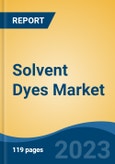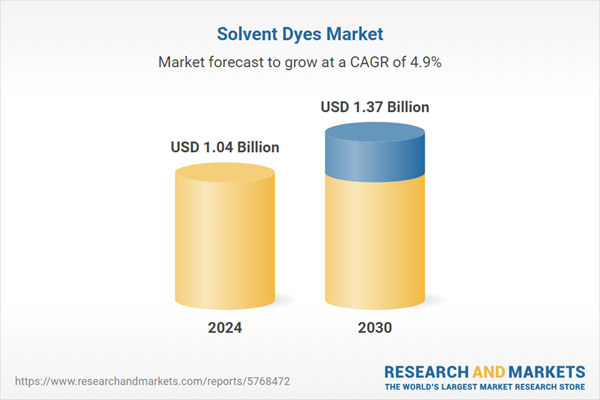Speak directly to the analyst to clarify any post sales queries you may have.
10% Free customizationThis report comes with 10% free customization, enabling you to add data that meets your specific business needs.
The global solvent dyes market is witnessing robust growth, driven by their extensive use in textiles, plastics, coatings, printing inks, and cosmetics. Solvent dyes, soluble in organic solvents like alcohols, ketones, and esters, offer vibrant colors, high lightfastness, and chemical resistance, making them ideal for coloring nonpolar materials such as plastics, fuels, and waxes. The market is propelled by rapid industrialization in developing economies, particularly in Asia-Pacific, where textile and plastic manufacturing thrives.
The automotive sector’s demand for durable coatings and the rise of e-commerce, requiring visually appealing packaging, further boost market growth. Regulatory frameworks, such as the EU’s REACH, push for eco-friendly formulations, aligning with consumer preferences for sustainable products.
The textile industry remains a primary driver, with solvent dyes enhancing color stability in polyester and nylon fabrics. In plastics, these dyes are critical for engineering plastics like polystyrene and ABS, used in automotive and electronics applications. The printing inks sector benefits from solvent dyes’ compatibility with digital printing, supporting high-quality outputs in packaging and advertising. The cosmetics industry increasingly adopts organic solvent dyes for their non-toxic properties, particularly in decorative products. Innovations in bio-based and low-VOC dyes address environmental concerns, while advancements in digital printing technologies expand applications.
Despite challenges like raw material volatility and regulatory compliance, the market is supported by R&D investments and growing demand in emerging markets. The forecast period of 2020-2030F is expected to see sustained growth as manufacturers leverage technological advancements to meet diverse industrial needs.
Key Market Drivers
Rapid Industrialization and Textile Industry Growth
The global solvent dyes market is significantly driven by rapid industrialization and the growth of the textile industry, particularly in emerging economies. Industry reports highlight the increasing production of synthetic fibers like polyester and nylon, which rely on solvent dyes for vibrant, durable coloring. The World Bank notes that industrial output in countries like China and India has surged, supporting textile manufacturing hubs. Policies promoting textile exports, such as India’s Production Linked Incentive (PLI) scheme, bolster demand for solvent dyes to meet global standards for colorfastness and aesthetics.Global clothing trade and sales volumes are projected to reach 175 million tonnes by 2050, more than triple the volume recorded in 2015. This rapid expansion underscores the growing scale of the global textile and apparel industry, which in turn drives heightened demand for solvent dyes. Solvent dyes are widely used in textile dyeing due to their excellent color strength, brightness, and fastness properties, especially on synthetic fibers like polyester and nylon. The increasing production of modern garments that emphasize stretchability, comfort, and versatility fuels the need for vibrant, durable, and high-performance dyes. As the apparel market continues to grow globally, solvent dyes remain essential for meeting the industry's demand for consistent and high-quality coloration, supporting robust market growth through 2050.
This trend is evident in Asia-Pacific, where China’s textile industry leads globally, driven by high demand for fast-fashion and technical textiles. Manufacturers are developing solvent dyes with enhanced lightfastness and chemical resistance to meet stringent quality requirements. The United Nations Industrial Development Organization emphasizes the role of industrial growth in driving demand for specialty chemicals, including dyes. Government initiatives, such as China’s Belt and Road Initiative, facilitate trade, increasing the need for high-quality dyed products. The integration of solvent dyes in digital textile printing further supports market growth, enabling customized designs. This driver is expected to propel the market through 2030, as industrialization and textile demand continue to rise.
Key Market Challenges
Raw Material Price Volatility
The solvent dyes market faces significant challenges due to raw material price volatility, particularly for petroleum-based chemicals like aromatics and esters. Geopolitical tensions, such as disruptions in the Middle East, impact supply chains, increasing costs for manufacturers. This issue is acute in Europe and North America, where import dependencies raise expenses.The need for consistent quality in high-volume applications like textiles and coatings adds pressure, as fluctuations disrupt production scalability. Smaller producers struggle to absorb costs, limiting their competitiveness. Addressing this requires diversified sourcing and investment in alternative feedstocks, but infrastructure limitations pose barriers. The industry must navigate these fluctuations to ensure stability through 2030.
Key Market Trends
Shift Toward Eco-Friendly and Bio-Based Dyes
The shift toward eco-friendly and bio-based solvent dyes is a key trend, driven by consumer demand and regulatory pressures for sustainable solutions. Manufacturers are developing dyes from renewable sources, such as plant-based solvents, aligning with policies like the EU’s Green Deal. This trend is prominent in Europe, where companies like BASF focus on low-VOC formulations for textiles and coatings.Bio-based dyes reduce environmental impact and improve recyclability, supporting applications in packaging and cosmetics. Reports highlight increased R&D investments in green chemistry, enhancing dye performance. This trend is expected to drive growth through 2030, as sustainability becomes a core focus across industries.
Key Market Players
- Nitin Dye Chem Pvt. Ltd.
- LANXESS AG
- Kunshan Organic Chemical Factory
- Megha International
- Kolorjet Chemicals Pvt Ltd.
- Nantong Saint Colorchem Co., Ltd.
- Tianjin Shenyuan Chemical Co., Ltd
- Hangzhou Epsilon Chemical Co., Ltd
- Hangzhou Sunny Chemical Co., Ltd.
- Winchem Industrial Co., Ltd
Report Scope:
In this report, global solvent dyes market has been segmented into following categories, in addition to the industry trends which have also been detailed below:Solvent Dyes Market, By Type:
- Metal Complex-Solvent Dyes
- Oil Soluble Dyes
- Water Soluble Dyes
- Other
Solvent Dyes Market, By Packaging:
- Bottle
- Bulk
- Tetra packaging
Solvent Dyes Market, By Application:
- Ink
- Plastics
- Fuel & Lubricants
- Coatings & Paints
- Others
Solvent Dyes Market, By Region:
- North America
- United States
- Canada
- Mexico
- Europe
- Germany
- France
- United Kingdom
- Spain
- Italy
- Asia-Pacific
- China
- India
- South Korea
- Australia
- Japan
- South America
- Brazil
- Argentina
- Colombia
- Middle East & Africa
- South Africa
- Saudi Arabia
- UAE
Competitive Landscape
Company Profiles: Detailed analysis of the major companies present in global solvent dyes market.Available Customizations:
With the given market data, the publisher offers customizations according to a company’s specific needs. The following customization options are available for the report.Company Information
- Detailed analysis and profiling of additional market players (up to five).
This product will be delivered within 1-3 business days.
Table of Contents
Companies Mentioned
- Nitin Dye Chem Pvt. Ltd.
- LANXESS AG
- Kunshan Organic Chemical Factory
- Megha International
- Kolorjet Chemicals Pvt Ltd.
- Nantong Saint Colorchem Co., Ltd.
- Tianjin Shenyuan Chemical Co., Ltd
- Hangzhou Epsilon Chemical Co., Ltd
- Hangzhou Sunny Chemical Co., Ltd.
- Winchem Industrial Co., Ltd
Table Information
| Report Attribute | Details |
|---|---|
| No. of Pages | 184 |
| Published | September 2025 |
| Forecast Period | 2024 - 2030 |
| Estimated Market Value ( USD | $ 1.04 Billion |
| Forecasted Market Value ( USD | $ 1.37 Billion |
| Compound Annual Growth Rate | 4.9% |
| Regions Covered | Global |
| No. of Companies Mentioned | 10 |









